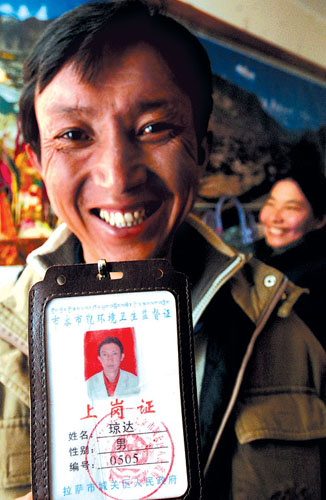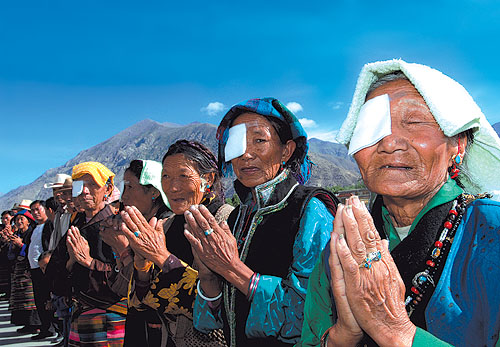|
In 2007, Tibet established the social insurance system mainly covering basic pension insurance, basic medical insurance, unemployment insurance for workers in cities and towns, work injury insurance and maternity insurance, formed the social assistance system with the minimum living standard security system for urban and rural residents and medical assistance system as the important point, and made great progress in social welfare and charity undertakings, with care and attention given to the old and weak. Social security and employment spending reached 1.678 billion Yuan a year-on-year increase of 63.35 percent. The coverage of the Basic Old Age Pension Insurance for Enterprise Staff has grown continuously and some 620 million Yuan was paid out. Tibet's basic medical insurance system for urban residents was launched in October of the same year. This shows how Tibet is moving to universal coverage of basic medical insurance.
Employment
 The government makes efforts to make all families have at least one working member.
The government makes efforts to make all families have at least one working member.
By the end of 2007, there were 1.5686 million employees in Tibet, a decrease of 86,600 from the end of 2006. The registered urban unemployment rate was 4.3 percent. In that year, the TAR Government constantly increased capital input in employment and re-employment. It earmarked 63 million Yuan in total to purchase 5,700 public welfare jobs, thus promoting the re-employment of aged people, the handicapped and zero-employment families, removing all 1,304 households from the latter category, making Lhasa City the first local capital to do so. In the same year, the government of Tibet Autonomous Region also allocated additional financial expense of 328 million Yuan to arrange the employment of 6,567 college and technical secondary school graduates, thereby making the their employment rate reach 82 percent. The employment and placement of demobilized soldiers also were properly solved.
Social Assistance
From 1997, Tibet started to establish the minimum living standard security system for urban residents. It first conducted pilot schemes in central Lhasa and then introduced the system in another six prefectures in 1998; by 2000, the program covered the whole region. Poverty-stricken urban residents, in line with their requirements, were incorporated into the scope of scheme. The security standard, 130 Yuan per person each month in 1997, was raised to 230 Yuan in 2007. A total of 36,000 urban residents enjoyed the benefit under the minimum living standard security system.
Starting from October 1, 2007, Tibet implemented the medical insurance system for urban residents in an all-round way, with 173,000 people being incorporated. To ensure the regular operation of the medical insurance system, the TAR government is charged with at least 28 million Yuan of fee collecting. The difficult groups, such as the people with minimum living standard security, seriously handicapped persons who have completely lost their labor capacity, and the childless elderly people who have no income, do not pay medical insurance premiums which are completely subsidized by the government. Each student only pays 30 Yuan each year, half the stipulated premiums, with the other half subsidized by the government.
 A charity hospital built with donations from Hong Kong compatriots. Many cataract sufferers have been treated as a result.
A charity hospital built with donations from Hong Kong compatriots. Many cataract sufferers have been treated as a result.
At the end of 2007, the number of workers and staff participating in the basic pension insurance reached 80,900 in Tibet, of which 30,500 had received old-age pensions. The number of people participating in unemployment insurance totaled 75,000. A total of 62.45 million Yuan of Minimum Living Standard Security funds was granted in the region.
On June 22, 2007, the TAR People's Government promulgated the Measures for the Implementation of the Minimum Living Standard Security for Rural Residents. It incorporated all the poverty-stricken farmers and herders whose per capita average net income was below 800 Yuan into the scope of the minimum living standard security, benefiting 230,000 poverty-stricken people. In addition, Tibet also incorporated poor people in rural areas, those with low income and the vulnerable group whose annual per capita average net income was below 500 Yuan, into the scope of scheme for poverty-stricken people needing living assistance. Following an investigation, the allowance is granted at a level that will enable them to reach the minimum living standard. In giving assistance, the principle is "guaranteeing in different types" to distinguish the elderly, minors and the handicapped who have no labor capability and have no other means of support.
For a long time, Tibet has held that rural households enjoying the five guarantees (childless and infirm old persons who are guaranteed food, clothing, medical care, housing and burial expenses) should be supported with a combination in concentrated and diverse forms, with priority given to the latter. The needed support funds come from central finance, while their needed living necessities such as grain ration and fuel are raised from the public. In 2003, Tibet raised the support standard given to the rural household enjoying the five guarantees from 588 Yuan to 900 Yuan per person. In 2004 and 2005, it rose to 1,200 Yuan and then 1,300 Yuan respectively, finally increasing to 1,500 Yuan in 2007, which is higher than the national average in this regard. Through the adjustments, the living standard of the household enjoying the five guarantees in the farming and pasturing areas of Tibet has markedly improved, and their rights and interests to basic living have been guaranteed.
At the end of 2007, there were 3,370 people taken in by welfare institutions with 3,677 beds. In 2006, the sale of 110 million Yuan worth of welfare lotteries raised 36.36 million Yuan in social welfare funds. Direct social donations totaled 3.62 million Yuan.
(China's Facts and Figures 2008) |
